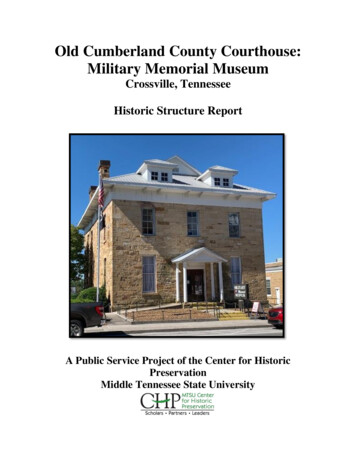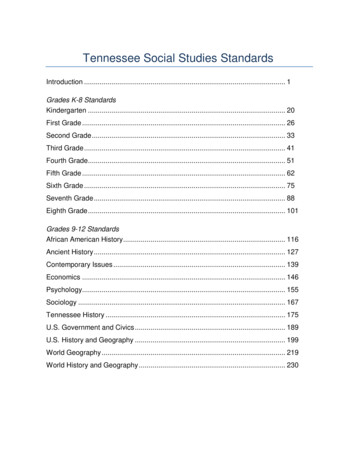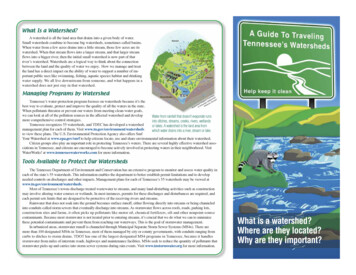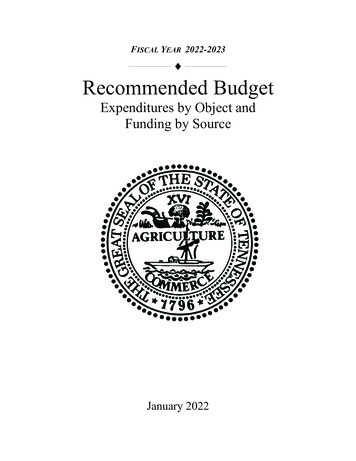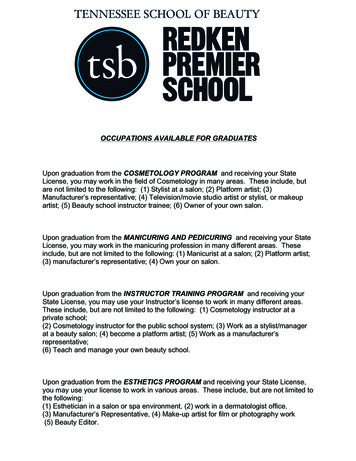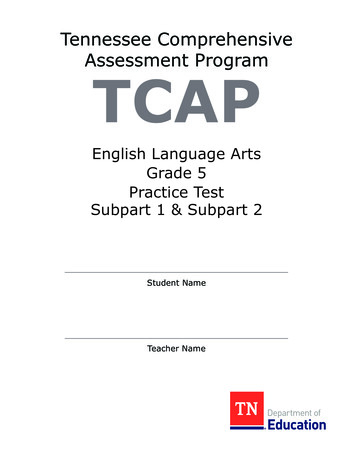
Transcription
Tennessee ComprehensiveAssessment ProgramTCAPEnglish Language ArtsGrade 5Practice TestSubpart 1 & Subpart 2Student NameTeacher Name
Published under contract with the Tennessee Department of Education by Questar Assessment Inc., 5550 Upper 147th Street West, Minneapolis, MN 55124.Copyright 2016 by Tennessee Department of Education. All rights reserved. No part of this publication may be copied, reproduced, or distributed in any formor by any means, or stored in a database or retrieval system, without the prior express written consent of the Tennessee Department of Education and QuestarAssessment Inc.
DirectionsTest Administrator Instructions:This practice test has Subpart 1 and Subpart 2. It is recommended that you print onecopy of this practice test and pull the answer key before copying and distributing thepractice test to your students. The answer key is found at the end of the practice test.This practice test is representative of the operational test but is shorter than the actualoperational test. To see the details about the operational test, please see the blueprintslocated on the Tennessee Department of Education website.3Go on
Grade 5 English Language Arts, Subpart 1 Practice TestDirectionsFor Subpart 1 of this Practice Test, you will read a passage or set of passages and thenwrite a response to a writing task. You will have 75 minutes to complete Subpart 1 ofthis Practice Test. This task gives you a chance to show how well you can organize andexpress your ideas in written text.After reading the passage(s) and writing task, take a few minutes to think about whatyou have read and to plan what you want to write before you begin to answer. Do yourbest to write a clear and well-organized response. Be sure to keep in mind your purposeand audience when developing your response.If you finish before the allotted time ends, review your work.4Go on
Grade 5 English Language Arts, Subpart 1 Practice TestRead the passage and write a response to the writing task.from “Think Like an Inventor”by Therese Heckenkamp1It was impossible for Steve to think of an idea for invention day with suchmouthwatering smells floating in the kitchen. A full stomach would help himthink better, he decided.2“What are you making, Mom?” he asked as he plopped onto a stool at thecounter.3“Too many things,” she said with a laugh. “Bread, cake, and apple pies. Butno sampling,” she warned, waving an apple peeler under his nose. “These are forSunday’s bake sale.”4Steve watched as Mom picked up an apple and turned it deftly in her hands,using the little peeler to shave curls of red skin. “That’s going to take forever,”he said, eyeing the waiting mountain of apples. Then he swiped an apple, figuringMom would probably be grateful.5“Just what I needed—a volunteer,” Mom said, turning and handing him thepeeler.6There has to be a better way of doing this, Steve thought as he scraped theblade against an apple. He kept missing spots, the peeler kept slipping in hishand, and he had to work slowly to avoid cutting himself.7“Inventions are often created as a result of trying to make a task easier,”Mrs. Nell had told the class. Peeling apples was a task that definitely needed to bemade easier.5Go on
Grade 5 English Language Arts, Subpart 1 Practice Test8Steve stayed up late that night drawing a diagram of his invention andlabeling its parts. The crank handle made it look like a pencil sharpener without acover. By merely turning this handle, you could make an apple turn roundand round underneath a blade until the apple was peeled cleanly from one endto the other. Much easier, thought Steve. He knew Mrs. Nell would beimpressed.9Steve grew so hungry imagining all the apple pies Mom could make if shehad a peeler like this that he almost sneaked into the kitchen to snitch a pieceof the pie she had baked that afternoon.10At school the next day, all the kids pinned their drawings on the bulletinboard. Steve stood by his diagram, eagerly waiting for Mrs. Nell to congratulatehim on his clever idea.11“Hey,” said Jenny, who had been walking around the room pushing hernose practically onto the paper as she examined each drawing. “What’s with theold-fashioned apple peeler?”12“Old-fashioned?” Steve scoffed. “No way. I just invented this yesterday.”13Jenny rolled her eyes. “Boy, are you dumb. That thing’s ancient! Mygrandmother has one. I’ll bring it tomorrow and prove it.”14Steve crossed his arms and said, “Huh,” as she walked away. He didn’t knowwhat else to say. How was he supposed to know someone had stolen his idea100 years ago? Then his stomach began to feel queasy. Now Mrs. Nell wouldthink he had copied someone else’s invention. That was worse than not tryingat all.15To get his mind off this, Steve began looking at the other inventions, butthat made him feel worse because they were all so much more impressive thanhis: a shark-detector swimsuit, a bed that made itself, and a pencil that knewhomework answers.16When it was Steve’s turn to describe his invention, he shuffled his feet andtried not to mumble the words he wished he didn’t have to say. “After Iinvented this apple peeler, I found out it had already been invented.” He triedto ignore Jenny’s smug smile.17“Don’t be discouraged,” Mrs. Nell surprised him by saying. “Even thoughsomething like this has already been invented, what matters is that you tookthe assignment seriously and focused on making an everyday task easier. Thatproves that you truly understood what this assignment was about. In fact,” she6Go on
Grade 5 English Language Arts, Subpart 1 Practice Testsaid with a chuckle, “I think reinventing something you never knew existed meansthat you must have the mind of an inventor.”1819Steve grinned. “Maybe I could modernize it with batteries,” he suggested.As Mrs. Nell moved on to the next invention, Steve decided that tomorrow hewould bring her an apple.Excerpt from “Think Like an Inventor” by Therese Heckenkamp, from Boys’ Quest. Copyright 2006.Published by Bluffton News Publishing.7Go on
Grade 5 English Language Arts, Subpart 1 Practice TestWriting TaskEven though Invention Day did not end the way Steve thought it would, he learnedsomething from his teacher. Write a narrative retelling the story from Mrs. Nell’s pointof view. Be sure to use what you have learned about the setting, characters, and plot ofthe passage. Follow the conventions of standard written English.Manage your time carefully so that you can Plan your response Write your responseYour written response should be in the form of a multi-paragraph narrative story.Write your response to the Writing Task in the space provided.8Go on
Grade 5 English Language Arts, Subpart 1 Practice Test9Go on
Grade 5 English Language Arts, Subpart 1 Practice Test10Go on
Grade 5 English Language Arts, Subpart 1 Practice TestThis is the end of Subpart 1 of the Grade 5 ELA Practice Test.Proceed to Subpart 2.11STOP
Sample QuestionsDirectionsThis Practice Test contains several types of questions. The following samples showthe types of test questions used. For all items, mark your answer(s) on the answerdocument provided.Sample 1: Multiple-choice (one correct response)1.What does the word cruel mean as it is used in paragraph 6?A. happyB. slowC. unkindD. easySample 2: Multiple-select (multiple correct responses)2.Read this sentence from paragraph 14.“Having a dog as a pet is a huge task.”Select two sentences that support this statement.A. Dogs show love and affection by licking faces.B. Dogs require being fed on a regular schedule.C. Dogs often help improve the health of their owners.D. Dogs make good companions for many people.E. Dogs need supplies and healthcare that can be costly.12Go on
This page is intentionally left blank.13Go on
Sample QuestionsSample 3: Two-part multiple-choice (with evidence responses)Read the passage and answer the questions that follow.from Heidiby Johanna SpyriHeidi, climbing on a chair, took down the dusty book from a shelf. After she hadcarefully wiped it off, she sat down on a stool.“What shall I read, grandmother?”“Whatever you want to,” was the reply. Turning the pages, Heidi found a songabout the sun, and decided to read that aloud. More and more eagerly she read,while the grandmother, with folded arms, sat in her chair . . . When Heidi hadrepeated the end of the song a number of times, the old woman exclaimed: “Oh,Heidi, everything seems bright to me again and my heart is light. Thank you,child, you have done me so much good.”Heidi looked enraptured1 at the grandmother’s face, which had changed froman old, sorrowful expression to a joyous one.Excerpt from Heidi by Johanna Spyri. In the public domain.1enraptured: very pleased14Go on
Sample Questions3.The following item has two parts. Answer Part A and then answer Part B.Part AHow does the grandmother feel when Heidi finishes reading?A. boredB. tiredC. happyD. patientPart BWhich quotation from the passage best supports the correct answer to Part A?A. “Heidi, climbing on a chair, took down the dusty book from a shelf.”B. “Turning the pages, Heidi found a song about the sun, and decided to readthat aloud.”C. “More and more eagerly she read, while the grandmother, with folded arms,sat in her chair.”D. “Heidi looked enraptured at the grandmother’s face, which had changed froman old, sorrowful expression to a joyous one.”Sample 4: Editing TaskSome test items require you to determine if an underlined word or phrase in apassage is used correctly.There are words or phrases in the passage that are underlined to showthey may be incorrect. For each underlined word or phrase, mark thecorrect replacement on the answer document provided.4.The creator of Mickey Mouse was born December 5, 1901, in Chicago. His namewas Walter Disney. He began drawing pictures when he were a young boy. Hisfirst drawings were of his neighbor’s horse, Rupert.Replace were withA. wereB. wasC. amD. is15Go on
Grade 5 English Language Arts, Subpart 2 Practice TestRead the passages and mark your answers on the answer document provided.Passage 1“The Potter and the Washerman”by Pam Hopper1Once there was a potter who made his living creating beautiful pottery fromfine porcelain. Not far from the potter lived a washerman who earned his livingmaking soiled laundry as bright and clean as new.2Both did well in their trades. However, the potter became jealous because heworried that the washerman was more successful than he was. He decided on asecret plan to ruin him.3The potter traveled to the palace and was granted an audience with the king.“What do you wish, potter?” asked the king.4“I have a simple request, Your Majesty,” replied the potter. “My neighbor,the washerman, is very good at what he does. I would like to help my neighborimprove his business.”5The king stroked his beard. “Why should the washerman’s business be ofany concern to you?” he asked.6The potter cleared his throat nervously and said, “Well, he is my neighbor,so naturally I desire what is best for him.”7The king looked intently at the potter. “What did you have in mind, potter?”8“A challenge, Your Highness. I propose that my neighbor wash one ofYour Majesty’s esteemed elephants until it is spotlessly clean. To successfullycomplete a challenge like that would increase his business a hundredfold, I amcertain.”9Having revealed his plan, the potter’s heart hammered so loudly he thoughtall would hear it. He hoped no one would guess the secret part of his plan: that thewasherman’s failure to complete such an impossible challenge would ruinhis business forever.10“I will consider your request,” said the king.11A few days later the potter was summoned before the king.12“I have just spoken with the washerman,” the king said, “and he is surprisedby your concern for his well-being. He is also troubled by one difficulty with16Go on
Grade 5 English Language Arts, Subpart 2 Practice Testyour idea, but knowing you are an accomplished potter, he thought you would beable to help him.”13Help the washerman ruin himself? This was better than the potter hadanticipated. “I am flattered by the washerman’s request, Your Majesty.”14“As you know,” continued the king, “in order to clean the soiled article, thewasherman puts it into a large porcelain basin with water and soap. Theconcern of the washerman is finding a porcelain basin large enough to wash anelephant. But then he remembered your exceptional talents as a potter, and hesuggested that you create such a container.”15This was terrible. Create a porcelain basin large enough for an elephant?Impossible. And yet, to refuse could destroy his own reputation. With tremblingknees, the potter agreed.16After many weeks of work the elephant-sized porcelain bowl was finallyready. On the day of the challenge the king’s largest elephant was brought tothe courtyard. The basin was carefully unloaded from the wagon and filled withwater and soap.17The washerman stood ready with his best scrub brushes. The elephant wasled up the ramp. Trumpeting, it stepped slowly into the delicate basin.18Would the basin hold the elephant?19It would not!2021With a crack, the porcelain basin shattered into a thousand pieces, sending afoamy river from the palace courtyard into the town below.All the people in the courtyard held their breath. What would the king say?22The king smiled gently at the potter. “My elephant is waiting to be bathed,and the washerman waits to prove his ability to wash him spotlessly clean. Wouldyou care to go home and create another basin so the washerman can do this?”23The potter gave great thought to his options and decided he had only onechoice: he quickly left the palace courtyard and was never seen again.24As for the washerman, his wisdom so impressed the king that he became oneof the most trusted advisers in the royal court.“The Potter and the Washerman” by Pam Hopper. Reprinted from Highlights for Children, June 1998,Vol. 53, No. 6, Highlights for Children, Inc.17Go on
Grade 5 English Language Arts, Subpart 2 Practice TestPassage 2“The Royal Artists and the Clever King”retold by Howard Schwartz and Barbara Rush25Once a very rich king ordered his subjects to build a new palace. And whenthe palace was finished, he wanted the finest artist in all the land to paintbeautiful pictures on its walls. But the king did not know which artist was thebest.26What did he do? He called forth two of the most famous artists in all theland, and he bade each artist to paint one wall of a room in the palace.Between the artists he hung a dark curtain, so that neither one could see whatthe other was doing.27To each of the artists he said, “You have three months in which to paint abeautiful picture on the wall. At the end of that time I will choose the bestpicture, and the artist who painted that picture will be given the honor ofdecorating the other walls of my royal home—and he will receive a large bag ofgold and jewels as well.”28Now one of the artists was talented and hard-working, and he set to work atonce. Out came his brushes, his paints, and his palette, and soon he washumming as he worked. This artist hardly slept. . . . Instead he thought only ofhis painting and of how to please the king.29But the other artist was lazy. Each day he remained in bed until noon. . . .And not once did he paint a stroke upon the wall.30In this manner three months passed. The hard-working artist painted all dayand all night. The lazy one did nothing.31But three days before the king was to look at their work, the lazy artistawoke and trembled. “I have done no work. I will be punished,” he stammered.“What should I do?” And from that moment on he could neither eat nor drinknor sleep. One day passed, two, three—and he could not think of a plan.32Then, on the night before the arrival of the king, he got an idea. What didhe do? The lazy artist brought a large bucket of black shiny oil, and brushed it onevery part of the wall until it was shiny as a mirror. Then he went to bed.33The next morning the king came to inspect the work of the two men. First hesaw the painting of the hard-working artist. How magnificent it was! . . .34The king was very pleased. He called upon the other members of his courts,and they too gasped in delight, “We have never seen anything so wonderful!”18Go on
Grade 5 English Language Arts, Subpart 2 Practice Test35Then the king pulled the curtain and looked at the work of the lazy artist. Itwas exactly the same as the other, line for line, stroke for stroke. . . . “How canthis be?” they gasped.36But the king, who was not easily fooled, saw at once the difference betweenthe work of the hard-working artist and that of the lazy one. And what did he do?37He took out just one large sack filled with gold and precious jewels. This heplaced near the painting of the hard-working artist. At once all of those presentsaw the same bag of gold appear by the other wall, beside the lazy man’s painting,and they realized it was only a reflection.38The king declared: “Each of you shall get the payment you deserve. Now,come forward and each of you take the reward you find beside your painting.” Andthey did!Excerpt from A Coat for the Moon and Other Jewish Tales. Copyright 1999. Published byThe Jewish Publication Society.19Go on
Grade 5 English Language Arts, Subpart 2 Practice Test1.The following item has two parts. Answer Part A and then answer Part B.Part AIn passage 1, how is the potter different in the first part of the story, compared tohow he is in the second part of the story?A. In the first part of the story, the potter wants to help his neighbor, but in thesecond part of the story, he no longer is able to.B. In the first part of the story, the potter is selfish, but in the second part of thestory, he no longer is.C. In the first part of the story, the potter wants to help the king, but in thesecond part of the story, he no longer does.D. In the first part of the story, the potter wants to hurt his neighbor, but in thesecond part of the story, he no longer thinks this is possible.Part BSelect two sentences from the passage that support the correct response inPart A.A. “He decided on a secret plan to ruin him.”B. “‘I have a simple request, Your Majesty,’ replied the potter.”C. “‘I will consider your request,’ said the king.”D. “After many weeks of work the elephant-sized porcelain bowl was finallyready.”E. “With a crack, the porcelain basin shattered into a thousand pieces, sending afoamy river from the palace courtyard into the town below.”F. “The potter gave great thought to his options and decided he had onlyone choice: he quickly left the palace courtyard and was never seenagain.”20Go on
Grade 5 English Language Arts, Subpart 2 Practice Test2.In passage 1, which word best helps the reader understand the meaning of theword porcelain in paragraph 1?A. livingB. potteryC. soiledD. business3.How does the narrator’s statement about the potter never being seen again helpreveal the theme of passage 1?A. It shows that the potter is willing to start over.B. It shows that the potter will find more work somewhere else.C. It shows that the potter must rethink his plan to hurt the washerman.D. It shows that the potter’s scheme to ruin the washerman only hurts himself inthe end.4.In passage 1, how are the actions of the potter and the washerman alike?A. They both work to improve the success of the other.B. They both tell the king the truth.C. They both think of a clever plan.D. They both show the king how wise they are.21Go on
Grade 5 English Language Arts, Subpart 2 Practice Test5.The following item has two parts. Answer Part A and then answer Part B.Part AWhat is the main theme of passage 2?A. People get the prize they have earned.B. Life has many surprises.C. Change is difficult to deal with.D. Helping others leads to rewards.Part BWhich detail from passage 2 best supports the theme?A. “Now one of the artists was talented and hard-working, and he set to work atonce.”B. “Then, on the night before the arrival of the king, he got an idea.”C. “The next morning the king came to inspect the work of the two men.”D. “At once all of those present saw the same bag of gold appear by the otherwall, beside the lazy man’s painting, and they realized it was only a reflection.”22Go on
Grade 5 English Language Arts, Subpart 2 Practice Test6.The following item has two parts. Answer Part A and then answer Part B.Part AWhich theme in passage 1 is similar to a theme in passage 2?A. It is more important to be clever than to be sincere.B. Wrongdoing is not usually rewarded.C. People cannot be told what to do.D. Hard work brings great joy.Part BWhat is a major difference in the way the two stories develop that theme?A. Passage 1 develops the theme by showing how the bad intentions of a personcan be avoided, while passage 2 develops the theme by showing how a personcan discover the truth even though it is disguised.B. Passage 1 develops the theme by relating the problems between people, whilepassage 2 develops the theme by showing that it is difficult to prevent beingtricked.C. Passage 1 develops the theme by explaining how people react to bad news,while passage 2 develops the theme by showing people covering up badfeelings.D. Passage 1 develops the theme by focusing on why people interact badly, whilepassage 2 develops the theme by showing how people get along.23Go on
Grade 5 English Language Arts, Subpart 2 Practice Test7.The following item has two parts. Answer Part A and then answer Part B.Part ASelect the line from passage 1 that best illustrates the king’s most importantdecision.A. “‘What did you have in mind, potter?’”B. “‘I will consider your request,’ said the king.”C. “‘I have just spoken with the washerman,’ the king said, ‘and he is surprisedby your concern for his well-being.’”D. “‘Would you care to go home and create another basin so the washerman cando this?’”Part BSelect the line from passage 2 that best illustrates the king’s most importantdecision.A. “Between the artists he hung a dark curtain, so that neither one could seewhat the other was doing.”B. “The next morning the king came to inspect the work of the two men.”C. “Then the king pulled the curtain and looked at the work of the lazy artist.”D. “‘Now, come forward and each of you take the reward you find beside yourpainting.’”24Go on
Grade 5 English Language Arts, Subpart 2 Practice TestRead the passage and mark your answers on the answer document provided.from “It’s a Jungle Up There”by Alison Pearce StevensCity roofs have a new color—green1School’s just let out and you’re waiting by the flag pole for your best friend.Leaves on the walls rustle as kids run out the doors. Butterflies flitter amongthe flowers blooming above the windows. You finally spot your friend. She’s upon the roof! Her class was studying the meadow that grows up there.2Although your school probably doesn’t look like this, one day it might. Greenroofs and living walls are popping up in cities all over the world. These plantcovered buildings are cool to look at, turning the city into a jungle of sorts, andcool to live around, by keeping temperatures from soaring. And that’s just thebeginning of what these city jungles can do.Going Green3Greening a building isn’t as easy as slapping some plants on a wall.Landscape architects—people who design gardens—have a lot of work to dobefore the plants can bloom.4First comes a waterproof layer and padding to protect the building. Nextcomes a layer to channel water, so heavy rains don’t drown the plants. Greenwalls are fitted with tubes that carry water and nutrients right to the plants’roots. Finally comes dirt for them to grow in. Ordinary dirt is too heavy, sogreen roofs and walls use special soil that is light and holds water well.5Now, finally, it’s time for the plants. Roof and wall gardeners choose theirplants very carefully. The plants must be able to stand heat, cold, and highwinds, and they should suit the local climate. Most green roofs are planted withwildflowers and hardy plants that can go a long time without rain. One rooftopfavorite is sedum, which has thick leaves that store water.6What plants are best for a wall? It depends on where the wall is. For sunnywalls, petunias or herbs like oregano might be good. Shady walls do better withbegonias, ferns, and even lettuce. The possibilities are almost endless: a green wallcan support hundreds of types of plants.25Go on
Grade 5 English Language Arts, Subpart 2 Practice TestCity Buffet7All that extra green attracts birds, bees, butterflies, and other wildlife. Infact, some green roofs shelter threatened species found almost nowhere else. Evensnails have been found up on rooftops.8Green walls and roofs can even grow food for people! Imagine buying foodthat was grown just down the street on a local rooftop. It would be super-fresh,and it would also help the environment because it wouldn’t have to be drivenlong distances in big trucks.Putting Nature to Work9City jungles are useful in other ways too. Green roofs trap rainwater, so lessflows into the city’s sewer system. Storm pipes can overflow during heavyrains—by sucking up extra water, green roofs can help prevent floods. Asrainwater sits on a green roof, plants and other organisms also naturally cleanthe water. Plants make oxygen for us to breathe and clean the air. And a nicethick layer of leaves on the outside of a building can even fight noise pollution,making that wailing ambulance seem a lot quieter.10Cities can get extra hot in summer. Glass and concrete bounce the sun’srays around, driving up the temperature. But plants release water into the air,which cools things down. It’s like when you sweat—as water evaporates, ittakes some heat with it.11In fact, the air outside a building with living walls can be as much as 18 F(8 C) cooler than the air outside a normal building. Green roofs have an evenbigger impact. A green roof is usually about the same temperature as the air.Compare that to a regular rooftop, which can be 70 F (21 C) hotter.12With all the benefits a city jungle has to offer, it’s only a matter of timebefore one sprouts up near you.Excerpt from “It’s a Jungle Up There,” by Alison Pearce Stevens. Reprinted from Ask, copyright 2013 by Carus Publishing.26Go on
Grade 5 English Language Arts, Subpart 2 Practice Test8.Which sentence best summarizes the passage?A. A city jungle is an inexpensive way to improve life in a city, but it is too difficultfor many people to build.B. Greening a building, a complicated process, is becoming popular because ofthe advantages it can bring.C. A green building can be more beneficial to people than to animals.D. A city jungle can improve the environment by cleaning the air and providing ahome to threatened species.9.Select two main ideas of the passage.A. There are many steps in greening a building.B. Wildflowers are planted on green roofs.C. Herbs grow well on sunny walls.D. Snails have been found on roofs.E. Green roofs are useful in several ways.F. Students enjoy studying rooftop gardens.27Go on
Grade 5 English Language Arts, Subpart 2 Practice Test10.The following item has two parts. Answer Part A and then answer Part B.Part AWhat does to channel mean as it is used in paragraph 4?A. to build upB. to mixC. to take awayD. to changePart BWhich phrase best supports the answer to Part A?A. “padding to protect the building”B. “so heavy rains don’t drown the plants”C. “walls are fitted with tubes that carry water”D. “that is light and holds water well”11.What is the relationship between a landscape architect and a roof andwall gardener?A. A landscape architect follows the instructions of a roof and wall gardener.B. A landscape architect must complete his or her job before a roof and wallgardener can begin.C. A landscape architect checks to make certain that a roof and wall gardener isready to work.D. A landscape architect is not as important as a roof and wall gardener.28Go on
Grade 5 English Language Arts, Subpart 2 Practice Test12.What is one benefit of a green building that the author implies but does notsupport with evidence?A. A green building can be educational for students.B. A green building can keep people drier in rainy weather.C. A green building can bring the members of a community together.D. A green building can help people feel good about contributing to theenvironment.13.The following item has two parts. Answer Part A and then answer Part B.Part AWhich statement best describes the relationship between city jungles and rain?A. City jungles raise the temperature by increasing the amount of water thatevaporates.B. City jungles let rainwater flow into sewers.C. City jungles keep certain kinds of wildlife from living on a roof.D. City jungles help control the amount of rain that reaches the ground.Part BWhich statement from the passage best supports the answer to Part A?A. “Green walls are fitted with tubes that carry water and nutrients right to theplants’ roots.”B. “The possibilities are endless; a green wall can support hundreds of types ofplants.”C. “Storm pipes can overflow during heavy rains—by soaking up extra water,green roofs can help prevent floods.”D. “A green roof is usually about the same temperature as the air.”29Go on
Grade 5 English Language Arts, Subpart 2 Practice Test14.The following item has two parts. Answer Part A and then answer Part B.Part AWhich detail does the author use to show one effect of green buildings oncities?A. Green buildings can help keep buildings warm.B. Green buildings can keep pests from invading buildings.C. Green buildings can prevent water from collecting on roofs.D. Green buildings can help regulate the temperature.Part BWhich statement from the passage best supports the answer to Part A?A. “Green walls are fitted with tubes that carry water and nutrients right to theplants’ roots.”B. “All that extra green attracts birds, bees, butterflies, and other wild
practice test to your students. The answer key is found at the end of the practice test. This practice test is representative of the operational test but is shorter than the actual operational test. To see the details about the operational test, please see the blueprints located on the Tennessee Department of Education website. 3 G Ö Directions
